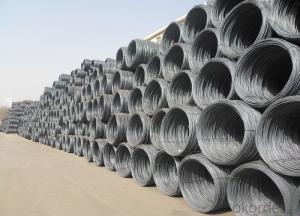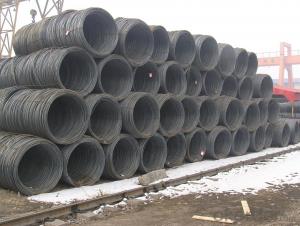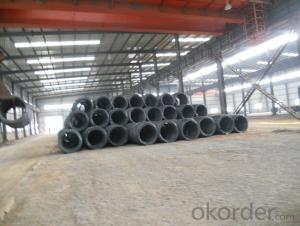Low Carbon Hot Rolled Steel Wire Rod in Coil
- Loading Port:
- China main port
- Payment Terms:
- TT OR LC
- Min Order Qty:
- 100 m.t.
- Supply Capability:
- 10000 m.t./month
OKorder Service Pledge
OKorder Financial Service
You Might Also Like
Item specifice
Product Description:
OKorder is offering Low Carbon Hot Rolled Steel Wire Rod in Coil at great prices with worldwide shipping. Our supplier is a world-class manufacturer of steel, with our products utilized the world over. OKorder annually supplies products to African, South American and Asian markets. We provide quotations within 24 hours of receiving an inquiry and guarantee competitive prices.
Product Applications:
Low Carbon Hot Rolled Steel Wire Rod in Coil are ideal for structural applications and are widely used in construction and manufacturing. Carbon steel wire rod is mainly used for reinforcement of reinforced concrete and welded structure or reprocessed (roberts , nail, etc.) materials, especially used to produce wire drawing, welding electrode, nails, spring, electronic, precise machinery parts and so on.
Product Advantages:
OKorder's Low Carbon Hot Rolled Steel Wire Rod in Coil are durable, strong, and wide variety of sizes.
Main Product Features:
· Premium quality
· Prompt delivery & seaworthy packing (30 days after receiving deposit)
· Can be recycled and reused
· Mill test certification
· Professional Service
· Competitive pricing
Product Specifications:
Manufacture: Hot rolled
Grade: Q195 – 235
Certificates: ISO, SGS, BV, CIQ
Packaging: Export packing, nude packing, in coils, each coil around 2mt
Size: 5.5mm, 6.5mm, 8mm, 10mm
Chemical composition (%): | C | Si | Mn | P | S | Ceq | |||
HRB335 HRBF335 |
0.25 |
0.80 |
1.60 |
0.045 |
0.045 | 0.52 | |||
HRB400 HRBF400 | 0.54 | ||||||||
HRB500 HRBF500 | 0.55 | ||||||||
Mechanical properties | Steel | Rel/ MPa | Rm/ MPa | A/ % | Agt/ % | ||||
≥ | |||||||||
HRB335 HRBF335 | 335 | 455 | 17 |
7.5 | |||||
HRB400 HRBF400 | 400 | 540 | 16 | ||||||
HRB500 HRBF500 | 500 | 630 | 15 | ||||||
FAQ:
Q1: Why buy Materials & Equipment from OKorder.com?
A1: All products offered byOKorder.com are carefully selected from China's most reliable manufacturing enterprises. Through its ISO certifications, OKorder.com adheres to the highest standards and a commitment to supply chain safety and customer satisfaction.
Q2: How do we guarantee the quality of our products?
A2: We have established an advanced quality management system which conducts strict quality tests at every step, from raw materials to the final product. At the same time, we provide extensive follow-up service assurances as required.
Q3: How soon can we receive the product after purchase?
A3: Within three days of placing an order, we will arrange production. The normal sizes with the normal grade can be produced within one month. The specific shipping date is dependent upon international and government factors, the delivery to international main port about 45-60days.
Images:
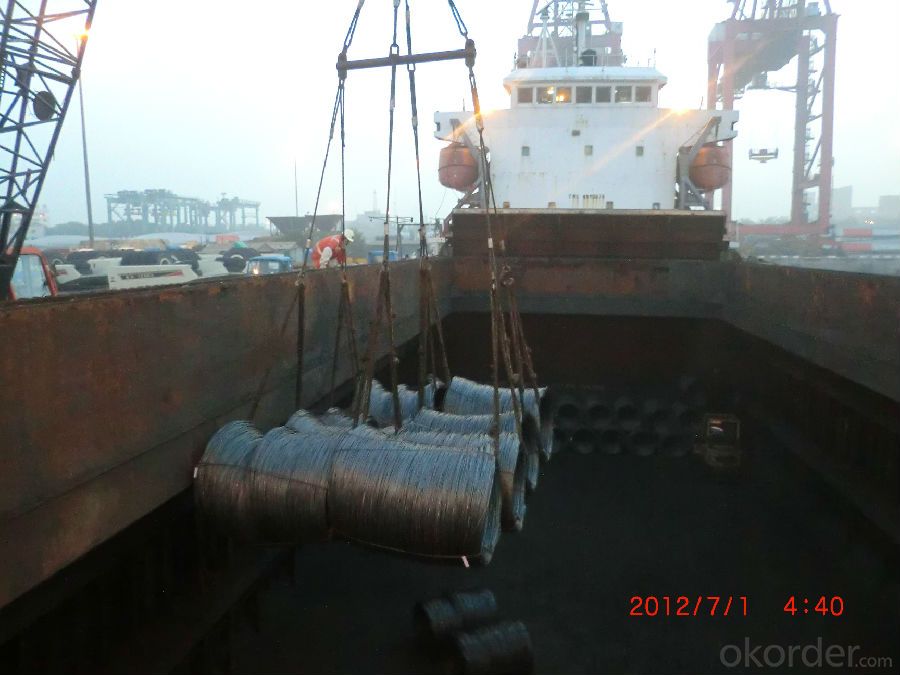
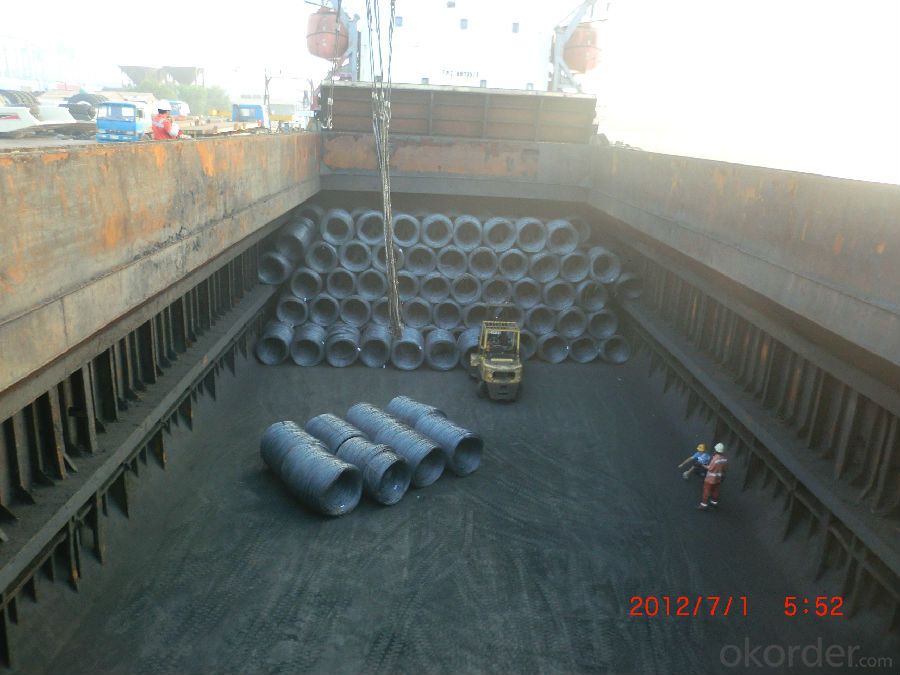
- Q:How is steel wire rod used in the manufacturing of wire mesh screens?
- Steel wire rod is used in the manufacturing of wire mesh screens as it serves as the primary material for the production of the wire mesh. The steel wire rod is first drawn into the desired thickness and then woven or welded together to create a mesh pattern. This mesh is then stretched and secured onto a frame to form a sturdy and durable wire mesh screen, which can be used for a variety of applications such as filtration, separation, protection, and reinforcement.
- Q:How is steel wire rod used in the manufacturing of wire for industrial sieves?
- Steel wire rod is used in the manufacturing of wire for industrial sieves as it serves as the raw material for creating the wire mesh. The wire rod is first processed through various steps such as drawing, annealing, and galvanizing to achieve the desired strength, flexibility, and corrosion resistance. Once transformed into wire, it is woven or welded to form the mesh used in industrial sieves. The durability, high tensile strength, and uniformity of steel wire rod make it an ideal choice for producing wire that can withstand the rigorous demands of industrial sieving applications.
- Q:How is the fatigue resistance of steel wire rod tested?
- The fatigue resistance of steel wire rod is typically tested using a cyclic loading test called the rotating bending fatigue test. In this test, a specimen of the steel wire rod is subjected to repeated cyclic bending under controlled conditions. The test begins by mounting the specimen onto a rotating device, such as a rotating beam or a rotating wheel. The specimen is then subjected to a cyclic bending load that varies in magnitude and direction. This load is applied by a mechanical or hydraulic device that applies the bending force to the specimen at a constant frequency. During the test, the number of cycles and the applied stress or load are carefully monitored. The test is usually conducted until the specimen fails due to fatigue, which is defined as the occurrence of cracks, fracture, or permanent deformation. The number of cycles required for failure is recorded as the fatigue life of the steel wire rod. To ensure accurate testing, multiple specimens are usually tested under different stress levels or load amplitudes. This allows for the determination of the fatigue strength of the steel wire rod, which is often expressed as the stress amplitude that can withstand a certain number of cycles without failure, such as 10^6 cycles. Overall, the rotating bending fatigue test provides valuable information about the fatigue resistance of steel wire rod, allowing manufacturers and engineers to assess its durability and suitability for various applications.
- Q:How is the diameter of a steel wire rod determined?
- The diameter of a steel wire rod is typically determined using a measuring instrument, such as a micrometer or caliper, which allows for precise measurements. The instrument is applied to the wire rod at multiple points along its length, and the average diameter is calculated based on these measurements.
- Q:Can steel wire rod be used in high-temperature applications?
- Yes, steel wire rod can be used in high-temperature applications. Steel has excellent heat-resistant properties and can withstand high temperatures without losing its strength or structural integrity. However, the specific grade and composition of the steel wire rod should be considered to ensure it is suitable for the intended high-temperature environment.
- Q:How is the steel wire rod industry regulated?
- The steel wire rod industry is regulated through a combination of government regulations and industry standards. Governments typically set regulations on areas such as product quality, safety standards, environmental impact, and labor practices. These regulations ensure that the industry operates within certain parameters to protect the interests of consumers, workers, and the environment. Additionally, industry standards and certifications are often established by professional associations or organizations to further regulate and ensure the quality and safety of steel wire rod products.
- Q:What are the main factors influencing the choice of steel wire rod surface finish?
- When determining the appropriate surface finish for a steel wire rod, several factors come into play, each playing a significant role. The intended use of the wire rod is one of the main factors to consider. Different surface finishes offer varying levels of corrosion resistance, lubricity, and adhesion properties. These properties are crucial in determining whether the wire rod is suitable for a specific application. For instance, in a corrosive environment, a surface finish that provides enhanced resistance to rust and oxidation may be necessary. The desired aesthetic appearance is another factor that influences the choice of surface finish. Industries like automotive or consumer goods may have specific requirements for the visual appeal of the wire rod. In such cases, finishes that offer a smooth, polished, or decorative appearance may be preferred. The mechanical properties required for the wire rod's application also play a role in determining the surface finish. Some finishes, such as bright or polished surfaces, can improve the wire rod's yield strength, ductility, and fatigue resistance. These properties are vital in applications involving high-stress conditions or requiring flexibility and durability. Cost considerations are also important when selecting the surface finish. Some finishes require additional processing steps, like pickling, coating, or electroplating, which can increase the overall cost of the wire rod. Therefore, it is essential to balance the desired surface finish with the cost-effectiveness of the manufacturing process. Lastly, environmental and regulatory factors can influence the choice of surface finish. Certain finishes may contain hazardous substances or require specific disposal methods, impacting the environmental footprint of wire rod production. Compliance with industry standards and regulations is crucial to ensure the safety and sustainability of the finished product. In conclusion, the choice of steel wire rod surface finish is influenced by factors such as intended use, aesthetic requirements, mechanical properties, cost considerations, and environmental considerations. By carefully considering these factors, manufacturers can select the most appropriate surface finish that aligns with the specific requirements of the application and ensures optimal performance and quality of the wire rod.
- Q:What are the common production processes for helium-coated steel wire rod?
- The common production processes for helium-coated steel wire rod typically involve several steps. First, the steel wire rod is cleaned and prepared for coating. Then, a thin layer of helium gas is applied to the surface of the wire rod through a specialized coating machine. This process helps to improve the wire rod's resistance to corrosion and enhance its durability. After the helium coating, the wire rod is usually subjected to a curing process to ensure proper adhesion of the coating. Finally, the coated wire rod is inspected for quality and packaged for distribution.
- Q:How is the corrosion resistance of steel wire rod improved?
- The corrosion resistance of steel wire rod can be improved through various methods such as coating it with a corrosion-resistant material like zinc or stainless steel, applying protective coatings like paint or epoxy, or using alloying elements such as chromium or nickel in the steel composition. Additionally, proper cleaning and maintenance practices can also help enhance its corrosion resistance.
- Q:What are the main components of a steel wire rod mill?
- The main components of a steel wire rod mill include a reheating furnace, roughing mill, intermediate mill, finishing mill, cooling bed, and coiling machines. The reheating furnace is used to heat the raw material, which is typically billets or ingots, to a temperature suitable for rolling. This helps in reducing the material's brittleness and improving its plasticity. The roughing mill is responsible for reducing the thickness of the heated material through a series of rolling passes. It consists of multiple stands of rolls that gradually decrease the size of the material. After the roughing mill, the material is passed through the intermediate mill. This mill further reduces the thickness and improves the surface quality of the wire rod. The finishing mill is the final stage of the rolling process. It consists of several stands of rolls that give the wire rod its final dimensions and surface finish. This mill is crucial in achieving the desired mechanical properties and dimensional accuracy of the wire rod. Once the wire rod is rolled to the desired shape and size, it is then transferred to the cooling bed. The cooling bed allows the wire rod to cool down gradually, preventing any deformation or cracking due to the high temperatures from the rolling process. Finally, the coiling machines are used to coil the wire rod into spools or coils, making it easier for transportation and storage. Overall, these main components work together in a steel wire rod mill to transform raw materials into high-quality wire rods that can be used in various industries such as construction, automotive, and manufacturing.
1. Manufacturer Overview |
|
|---|---|
| Location | |
| Year Established | |
| Annual Output Value | |
| Main Markets | |
| Company Certifications | |
2. Manufacturer Certificates |
|
|---|---|
| a) Certification Name | |
| Range | |
| Reference | |
| Validity Period | |
3. Manufacturer Capability |
|
|---|---|
| a)Trade Capacity | |
| Nearest Port | |
| Export Percentage | |
| No.of Employees in Trade Department | |
| Language Spoken: | |
| b)Factory Information | |
| Factory Size: | |
| No. of Production Lines | |
| Contract Manufacturing | |
| Product Price Range | |
Send your message to us
Low Carbon Hot Rolled Steel Wire Rod in Coil
- Loading Port:
- China main port
- Payment Terms:
- TT OR LC
- Min Order Qty:
- 100 m.t.
- Supply Capability:
- 10000 m.t./month
OKorder Service Pledge
OKorder Financial Service
Similar products
New products
Hot products
Related keywords
